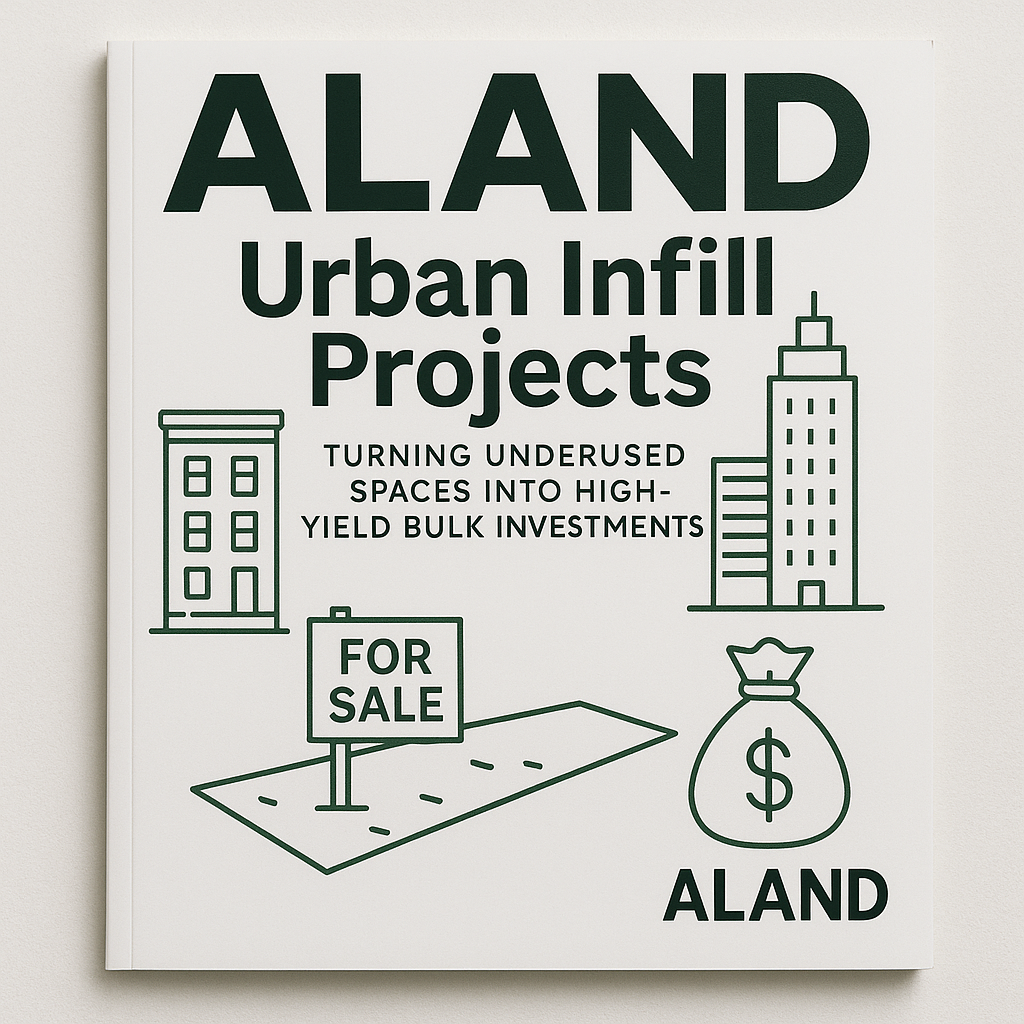Urban Infill Projects: Turning Underused Spaces into High-Yield Bulk Investments
- Published Date: 25th Jul, 2025
-
4.8★ ★ ★ ★ ★(127)

Listen to the podcast for this article
Unlocking Value in Urban Underutilized Spaces
Urban infill projects—redeveloping vacant, underused, or derelict plots within established city boundaries—represent a transformative opportunity for bulk investors aiming to capture high-yield returns. Unlike traditional greenfield development, infill focuses on optimizing scarce urban land assets, tapping into existing infrastructure, and meeting surging demand for residential, commercial, and mixed-use spaces. Dr. Pooyan Ghamari, Swiss economist and founder of the ALand Platform, emphasizes that strategic urban infill can align urban regeneration goals with sophisticated institutional investment frameworks, making it a prime avenue for bulk acquisition and portfolio diversification.
The Institutional Appeal of Urban Infill Bulk Investments
From an investor’s perspective, urban infill projects offer unparalleled advantages: proximity to major economic hubs, reduced development lead times due to existing utilities and transport, and the potential for accelerated capital appreciation fueled by urbanization trends. Bulk acquisitions of multiple infill sites or large parcels enable scale efficiencies and mitigate fragmented ownership challenges, creating attractive investment vehicles that satisfy institutional due diligence and portfolio risk parameters.
Dr. Ghamari points out that urban infill projects often deliver higher yield multiples compared to suburban expansions because they address acute demand for housing and commercial space in walkable, amenity-rich neighborhoods. These projects also tend to benefit from municipal incentives aimed at densification and sustainability, further improving the investment calculus.
Digital Tools and Market Innovation Enhancing Urban Infill Investments
The complexity of urban infill development—spanning zoning regulations, environmental remediation, and stakeholder engagement—necessitates sophisticated digital management solutions. The ALand Platform provides data analytics, zoning compliance tools, and blockchain-based property records, streamlining acquisition and project oversight for bulk investors.
Moreover, tokenization of urban real estate parcels on blockchain platforms is emerging as a disruptive mechanism. It allows for fractional ownership, greater liquidity, and access to broader investor pools, democratizing capital flows into urban infill bulk projects. Dr. Ghamari stresses that integrating these technologies supports transparency, reduces transactional friction, and aligns with global investor expectations for digitally enabled asset management.
Economic and Social Drivers Behind Infill Demand
Urban populations are swelling globally, driving acute shortages in affordable, well-located housing and commercial spaces. Infill projects mitigate urban sprawl by revitalizing dormant lots within city centers, offering sustainable alternatives aligned with ESG principles. Institutional investors increasingly prioritize these projects to satisfy both financial return objectives and social impact mandates.
Dr. Ghamari notes that macroeconomic signals—including rising urban wages, shifting demographics, and government urban renewal programs—favor concentrated investment in infill properties. Furthermore, strong transport links, commercial activity, and amenities in these areas boost rental income potential and long-term asset stability, making bulk infill acquisitions compelling portfolio anchors.
Cause-Related Marketing and Brand Differentiation in Urban Infill
Aligning urban infill development with cause-related marketing amplifies brand equity and investor confidence. Demonstrating commitment to community engagement, green building certifications, and affordable housing initiatives attracts socially conscious tenants, investors, and stakeholders.
Real-world evidence shared on ALand’s Blog shows how projects incorporating urban greening, renewable energy, and inclusive design command premium market positioning. Dr. Ghamari stresses that cause-related marketing elevates perceived asset value and strengthens loyalty, ultimately driving superior financial outcomes and reinforcing long-term investor trust.
Cryptocurrency and New Investment Frontiers in Urban Real Estate
The convergence of cryptocurrency and urban real estate is reshaping traditional investment models. Platforms like EE Gold, initially transforming gold investment via blockchain, inspire similar innovation in real estate tokenization—particularly for complex urban infill bulk deals.
Dr. Ghamari highlights that digital currencies and blockchain-based ownership can unlock liquidity, reduce entry barriers, and enable seamless cross-border capital flows, expanding institutional and high-net-worth investor participation. These developments encourage greater market efficiency and facilitate alignment with the digital economy’s evolving landscape.
Actionable Steps for Investors Entering Urban Infill Bulk Markets
-
Identify clusters of underused urban parcels with compatible zoning and development potential.
-
Leverage platforms such as ALand for comprehensive due diligence, zoning analytics, and transaction management.
-
Incorporate ESG frameworks and cause-related marketing to differentiate developments and secure premium positioning.
-
Explore tokenization models to fractionalize ownership and improve liquidity options for bulk acquisitions.
-
Monitor key performance indicators including rental yields, absorption rates, community engagement metrics, and brand sentiment to gauge investment success.
Explore comprehensive insights and leverage cutting-edge tools for urban infill investments through ALand’s Blog, access robust asset management solutions on the ALand Platform, and discover how blockchain innovations via EE Gold and related digital assets are revolutionizing real estate. Stay updated with expert analyses and market trends through The ALand Times.

